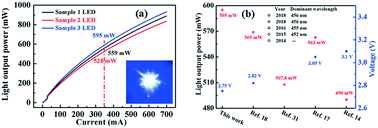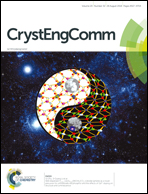Performance-improved vertical GaN-based light-emitting diodes on Si substrates through designing the epitaxial structure
Abstract
Performance-improved vertical GaN-based light-emitting diodes (LEDs) have been fabricated on Si substrates through designing the epitaxial structures with a combination of an AlN interlayer and a SiNx interlayer. The AlN interlayer is used to introduce more compressive stress in GaN epitaxial films to balance the tensile stress formed in thick n-GaN epitaxial films from cracking, and the SiNx interlayer is employed to annihilate the dislocation density to improve the crystalline quality of GaN epitaxial films. By using the optimized epitaxial structures, high-quality crack-free GaN-based LED wafers have been obtained. The full-widths at half-maximum from the GaN(0002) and GaN(10−12) X-ray rocking curves are as small as 280 arcsec and 310 arcsec, respectively. The hetero-interfaces of the InGaN/GaN multiple quantum wells are sharp and abrupt. After the LED wafers are fabricated into vertical LED chips, they reveal high-performance with a high light output power of 595 mW and a small working voltage of 2.75 V with an electroluminescence dominant wavelength of 456 nm @ 350 mA, corresponding to a wall-plug efficiency (WPE) as high as 61.8%. These performance-improved vertical LED chips open a broad prospect in the application of high-end lighting applications.



 Please wait while we load your content...
Please wait while we load your content...